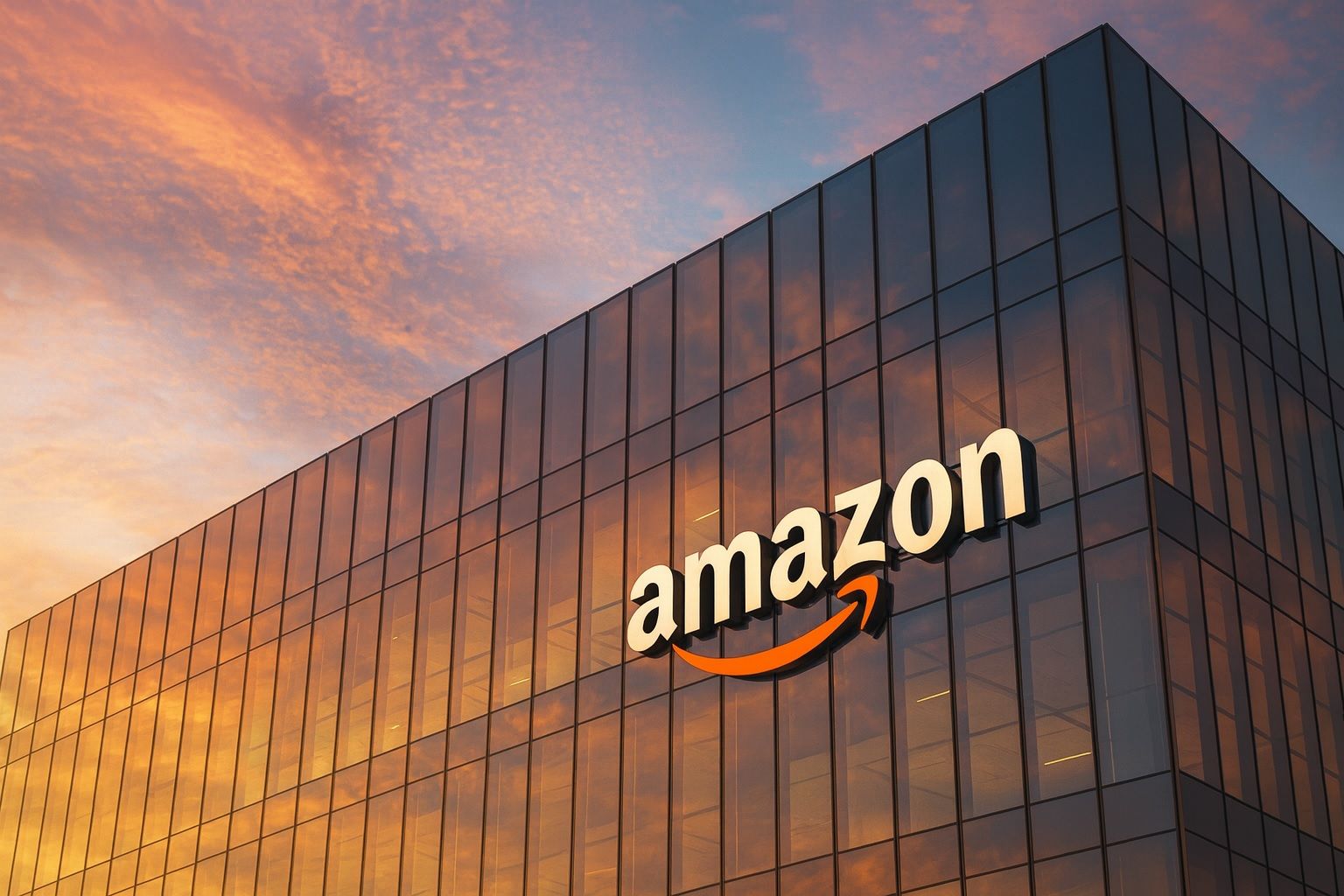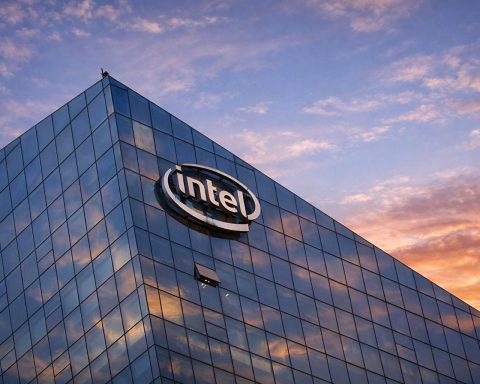- Price (Oct 22, 2025): Around $218 per share (close) [1]. Year-to-date performance is roughly flat (about –1%), significantly lagging the Nasdaq’s ~+20% gain [2] [3].
- Earnings (Q3’25): Report due Oct. 30 after market close. Analysts expect ~$1.57 EPS on ~$177.53 billion revenue [4] (Amazon’s guidance: $174–179.5 billion sales, +10–13% YoY) [5]. In Q2, Amazon beat estimates (EPS $1.68 vs. $1.31 est; revenue $167.7B vs. $161.8B est) [6].
- AWS Outage (Oct 20): A widespread AWS disruption briefly knocked out thousands of websites. Amazon restored service the same day, and shares actually jumped ~1.6% on Oct. 20 [7], signaling investor confidence in AWS’s long-term reliability.
- Analyst Ratings: Nearly all analysts rate AMZN a “Buy.” Consensus 12‑month price target is in the mid-$260s (roughly +20% upside) [8] [9]. Top targets include Goldman Sachs $275 [10] and Wells Fargo $280 [11].
- Growth Drivers: High-margin segments are accelerating. AWS revenue grew ~17% YoY last quarter (to ~$30.8B) and Advertising rose ~22% (to $15.7B) [12]. Amazon’s e-commerce remains resilient (Q2 online sales +11% YoY [13]), aided by recent Prime Day–style sales (Oct 7–8 “Prime Big Deal Days” bolstered holiday outlook [14]).
- Peer Context: Amazon has lagged some peers. Apple and Microsoft reached record stock highs on strong results and AI momentum, while Amazon is the only big tech name down in 2025 [15] [16]. Competitors like Google Cloud and Azure grew much faster (39%/32% vs AWS’s 17.5% last quarter [17]). Walmart (around $107/share [18]) is investing in AI to catch up in retail [19], but Amazon is also expanding in groceries (a $600B US market) [20].
Investors will be watching Amazon closely after recent turbulence and ahead of its Q3 results. On Oct. 20 a major AWS outage – one of the largest Internet disruptions in years – knocked thousands of popular apps and sites offline, from banking portals to gaming platforms [21]. Crucially, Amazon’s engineers fixed the issue by evening, and Wall Street shrugged it off. In fact, AMZN stock rallied 1.6% on Oct. 20 (closing around $216.50) [22], as one analyst noted: “the spotlight was firmly on AWS and it didn’t quite shine as brightly as expected” [23], yet investors seemed more focused on Amazon’s overall cloud momentum than a one-day glitch. This positive reaction underscores confidence that AWS remains a dominant cloud provider despite strong competition [24] [25].
Amazon’s share price has since stabilized in the mid-$210s. Trading has found support near the 200-day moving average (~$213) after a volatile start to October [26]. In the past week, AMZN has traded roughly flat while the rest of the tech sector has rallied. By contrast, peers like Apple surged to fresh highs (Apple hit an all-time high Oct. 21 on robust iPhone demand) and Microsoft gained on booming AI-driven cloud growth. Year-to-date Amazon is essentially flat (down about 1%), making it the worst performer of the “Magnificent Seven” tech stocks so far in 2025 [27] [28]. This relative underperformance follows a blistering 44% rally in Amazon stock in 2024, so some analysts see this as consolidation before the next leg up.
On the fundamentals front, Amazon just reported a strong Q2 (fiscal Q3) in late July: EPS was $1.68, well above the $1.31 expected, and revenue hit $167.7 billion (+13% YoY) [29]. Investors are now looking ahead to Q3 (fiscal) results on Oct. 30 after market close. Wall Street’s consensus forecast is about $1.57 EPS on $177.5B sales [30], in line with Amazon’s guidance for $174–179.5B (10–13% revenue growth) [31]. Those numbers would represent continued solid growth in retail sales alongside continued strength in AWS and advertising. Importantly, Amazon expects operating profit to be higher year-over-year in Q3 (despite higher spending on faster delivery and AI), which would reassure investors focused on margins.
Amazon’s key growth engines are firing. In its last quarter, AWS revenue rose ~17% YoY to about $30.8 billion, while its ads business grew ~22% to $15.7 billion [32], making Amazon the third-largest digital ad platform worldwide. These high-margin segments have boosted profitability and are widely credited for Amazon’s long-term value. Meanwhile, Amazon’s core e-commerce business continues to see double-digit growth [33]. The recent Oct.7–8 “Prime Big Deal Days” event gave an early jolt to holiday sales, pulling forward consumer demand and clearing inventory [34]. The company has also rolled out faster delivery options and new Prime benefits (e.g. adding items to scheduled deliveries) to entice shoppers.
Analysts remain overwhelmingly bullish. TipRanks and market-tracking services show 45 out of 46 covering analysts rate Amazon a Buy or Strong Buy [35]. The average 12-month price target is around $264–267, about 20–25% above current levels [36] [37]. Major firms have been lifting targets: Goldman Sachs now has a $275 target (up from $240) and calls AMZN a “Top Pick” [38], citing underestimated strength in cloud and advertising. Wells Fargo in late Sept. also upgraded AMZN to Overweight with a $280 target (from $245) [39]. BMO Capital, after industry checks, forecasts AWS growth will reaccelerate in the back half of 2025. Wedbush’s tech team argues that enterprise AI demand is still building — they say analysts are “underestimating” the AI-driven spending boom. As Wedbush’s Dan Ives puts it, a better-than-expected Q3 from the cloud giants (Amazon, Microsoft, Google) could spark a new wave of investment.
That said, Amazon’s valuation is rich (forward P/E in the low 30s [40]), so some caution remains. Regulatory and other overhangs have faded: Amazon agreed to a $2.5 billion FTC settlement over Prime disclosures (clearing a legal cloud) and even scored a win in Europe (an Italian court halved a previous antitrust fine [41]). The recent disclosure that ex-wife MacKenzie Scott sold $12.6B of shares for charity briefly spooked the stock (a ~2% dip), but analysts noted it was unrelated to fundamentals [42]. Overall, sentiment is that these issues are behind Amazon.
In a broader context, Amazon’s peers highlight both challenges and validation. Apple’s stock has been surging on strong hardware demand, helping lift the Nasdaq to new heights. Microsoft’s Azure and Google Cloud saw massive growth last quarter (39% and 32%, respectively [43]), underlining intensifying cloud competition. Walmart, trading around $107, is stepping up in tech to counter Amazon; Walmart just announced an OpenAI partnership for ChatGPT-powered shopping, sending its shares up 5% [44]. Still, Amazon is not standing still — Morgan Stanley notes that Amazon is aggressively expanding in groceries (the ~$600 billion U.S. market) to challenge Walmart [45], and Amazon’s size and innovation in logistics and AI give it an edge.
Outlook: Wall Street’s consensus outlook is sunny if results hold up. Analysts generally expect double-digit percentage growth to continue. Many models project roughly 15%+ annual EPS growth over the next 5 years as Amazon’s higher-margin cloud and ads businesses take up more of the pie [46]. If that comes to pass, some bulls even speculate Amazon could eventually join Apple (and possibly Microsoft) in the ~$3 trillion market-cap club [47]. In the short term, most firms have 12-month targets in the mid- to high-$200s (implying upside into 2026). In fact, the median one-year target among analysts is about $264–267 [48] [49] (roughly +20% from here), and technical analysts note a break above this year’s $242 high could open the door to the upper-$200s.
With Q3 earnings just days away, the immediate question is whether Amazon can sustain its momentum. Investors will be looking for continued strength in AWS growth and ad sales, as well as guidance for the all-important holiday season. But given Amazon’s scale and multiple levers of growth, most experts remain bullish. As one investor note put it, “the stock is currently on sale, down about 11% from all-time highs” – perhaps seen as a buying opportunity for believers in Amazon’s long-term dominance [50]. All eyes now turn to that Oct. 30 report and the holiday shopping season to gauge how high this cloud-punctured rocket might fly next.
Sources: Market data and analyst reports [51] [52]; TechStock² analysis (Ts2.tech) [53] [54] [55]; Reuters news coverage [56] [57]; Morningstar/stockanalysis consensus forecasts [58] [59]. (Charts, interviews and official filings)
References
1. stockanalysis.com, 2. ts2.tech, 3. www.investopedia.com, 4. www.marketbeat.com, 5. ts2.tech, 6. www.marketbeat.com, 7. ts2.tech, 8. stockanalysis.com, 9. ts2.tech, 10. ts2.tech, 11. www.marketbeat.com, 12. ts2.tech, 13. www.reuters.com, 14. ts2.tech, 15. ts2.tech, 16. www.investopedia.com, 17. www.reuters.com, 18. www.reuters.com, 19. www.reuters.com, 20. ts2.tech, 21. www.reuters.com, 22. ts2.tech, 23. www.reuters.com, 24. ts2.tech, 25. www.reuters.com, 26. ts2.tech, 27. ts2.tech, 28. www.investopedia.com, 29. www.marketbeat.com, 30. www.marketbeat.com, 31. ts2.tech, 32. ts2.tech, 33. www.reuters.com, 34. ts2.tech, 35. ts2.tech, 36. stockanalysis.com, 37. ts2.tech, 38. ts2.tech, 39. www.marketbeat.com, 40. www.marketbeat.com, 41. ts2.tech, 42. ts2.tech, 43. www.reuters.com, 44. www.reuters.com, 45. ts2.tech, 46. ts2.tech, 47. ts2.tech, 48. stockanalysis.com, 49. ts2.tech, 50. ts2.tech, 51. www.marketbeat.com, 52. stockanalysis.com, 53. ts2.tech, 54. ts2.tech, 55. ts2.tech, 56. www.reuters.com, 57. www.reuters.com, 58. stockanalysis.com, 59. ts2.tech







